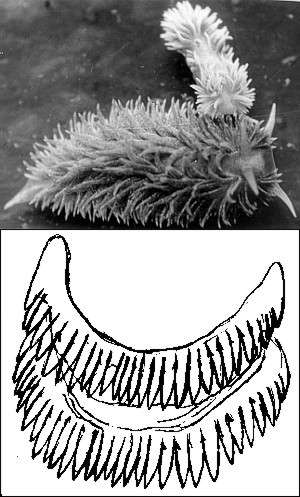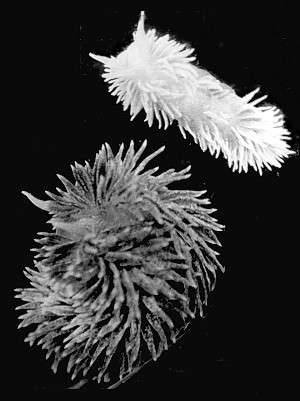Albino Aeolidia papillosa
September 18, 1999
From: Irina Roginskaya


Dear Bill,
Here are two photos of albinistic specimen of Aeolidia papillosa from the White Sea. It seems to me that the records of albinos among nudibranchs are rather rare (with the exception of cave dwellers. e.g., (Belcik, 1975; Cattaneo, 1982) and deep-water species (e.g. Rudman, 1972)). During my more than 20 years long searching for nudibranchs in the vicinity of the White Sea Biological Station of Moscow State University I had seen the albinistic exemplar only once. This white specimen of Aeolidia papillosa (L) was discovered 19.09.1987 at low tide near the White Sea Biological Station of Moscow State University (Kandalasha Bay, Velikaya Salma Strait), in a shallow residual pool on the silty-sandy rather polluted bottom near the pier, in company of four normally pigmented grayish brown A. papillosa. The white specimen differed from its normal fellows by the complete absence of pigmentation, by the much lesser size - 3cm in length, (while the four normally pigmented A.papillosa attained 6.0-7.5 cm), and by the group of rows with short regenerating papillae on the right side of the body.
The behaviour of the white and the four normally coloured specimens was just the same. Regaining with returning water their usual lively appearance (after forced immobility during low tide) the five animals together rushed towards the place of aggregation of their food objects - the olive-green actiniarians Bunodactis stella almost buried up to the oral disk in the sand. In captivity being accustomed to twice a day drying the white specimen together with other A. papillosa at the time of low tide tried to climb out from the aquarium.
Despite the milky white coloration of the body and cerata the specimen retained some colour peculiarities of normally coloured A. papillosa. That is, the opaque snowy-white “dust” more white that the milky-white background, clearly seen on the upper 2/3 of each dorsal papilla, on the basic part of the rhinophores and the oral tentacles, and especially on the upper surface of the head, where the dense snowy-white specs of “dust” created the triangle, which is characteristic for the species. The anatomical study of the white specimen revealed the usual radula, composed of 23 rows of pectinate teeth and the normally pigmented black eyes.
Externally the white specimen was looking like the true albino. Though if the albinism is innate genetic anomaly, linked with the blocking of the synthesis of pigments, mainly melanin, the retain of eye pigmentation permits us to speak only about the partly albinism. The presence of the melanin in the eyes points to the presence of the dominant gene of normal pigmentation, necessary for the elaboration of pigment in the organism. Perhaps here we are dealing with albinism arising as the display of the gene of patchiness, when the whole surface of the body may prove to be the single white spot, and then the albinos may retain eye pigmentation?
Roginskaya, I.S. (1990) Albino Aeolidia papillosa, collected in the intertidal zone of the White Sea (Gastropoda, Nudibranchia). Zoologicheskiy Zhurnal (Russian Journal of Zoology), 69(3): 125-127. (in Russian).
Irina Roginskaya
irina7@hotmail.com
Roginskaya, I., 1999 (Sep 18) Albino Aeolidia papillosa. [Message in] Sea Slug Forum. Australian Museum, Sydney. Available from http://www.seaslugforum.net/find/1349Dear Irina,
Thanks for the information.
Bill Rudman
Related messages
-
Aeolidia papillosa from French Atlantic
From: Marina Poddubetskaia Ossokine, August 17, 2009 -
Re: Aeolidia papillosa spawn
From: Jackie Hildering, August 1, 2008 -
Re: Aeolidia papillosa spawn
From: Jackie Hildering, August 1, 2008 -
Stars don't eat slugs
From: Jan Kocian, July 11, 2007 -
Aeolidia papillosa from British Columbia
From: Marli Wakeling, March 26, 2007 -
Aeolidia papillosa? from southern Oregon
From: Sandy Grummon, March 1, 2007 -
Large Aeolidia papillosa from Puget Sound
From: Richard Zade, February 8, 2007 -
Juvenile Aeolidia papillosa?
From: Carmelita Hansen, May 11, 2006 -
Aeolidia papillosa - Mating and Feeding
From: Philipp Kauffmann, May 24, 2005 -
Aeolidia papillosa from Puget Sound, Washington
From: Tom Hankins, February 22, 2005 -
Aeolidia papillosa vs Flabellina salmonacea
From: Mary Jo Adams, January 29, 2004 -
Aeolidia papillosa - mating
From: Richard Lord, August 29, 2003 -
Aeolidia papillosa feeding
From: Alan Shepard, August 23, 2003 -
Re: Information about Aeolidia papillosa
From: Peter H. van Bragt, November 4, 2002 -
Information about Aeolidia papillosa
From: Moria Eggers, October 30, 2002 -
Aeolidia papillosa feeding
From: Andy Horton, September 30, 1999 -
Aeolidia papillosa spawn
From: Andy Horton, September 29, 1999 -
Aeolidia papillosa from the White Sea
From: Irina Roginskaya, September 8, 1999 -
Colour variation in Aeolidia papillosa
From: Betsey Hansen, September 5, 1999 -
Aeolidia papillosa - Feeding & breeding
From: Betsey Hansen, September 3, 1999 -
Aeolidia papillosa from the Netherlands
From: Peter H. van Bragt, September 2, 1999 -
Aeolidia papillosa from New York
From: Betsey Hansen, September 2, 1999
